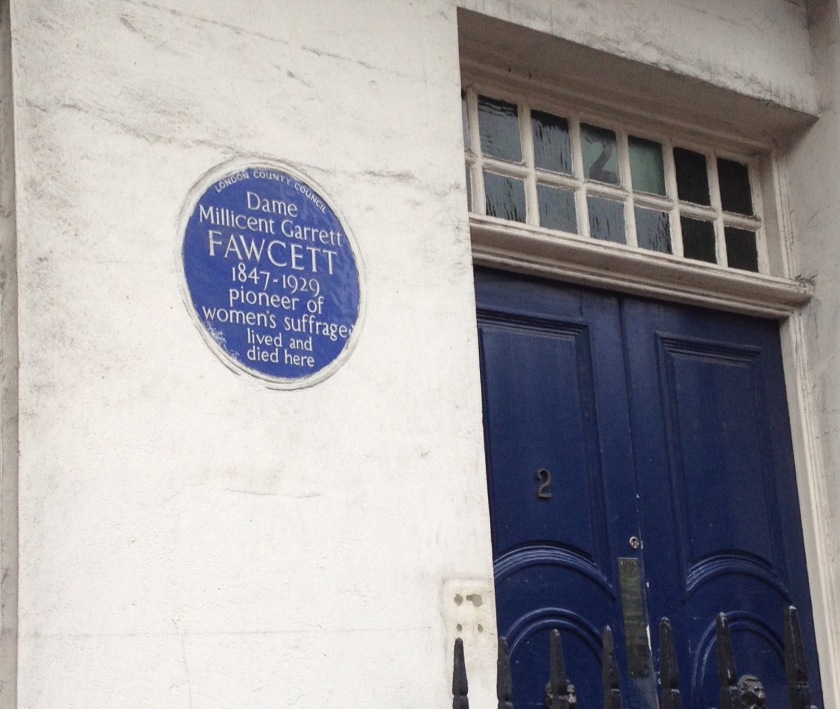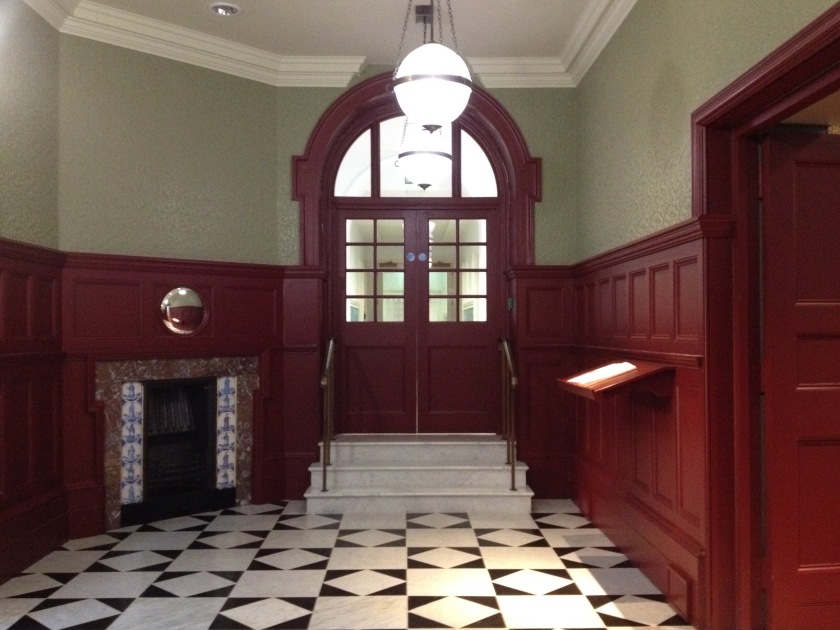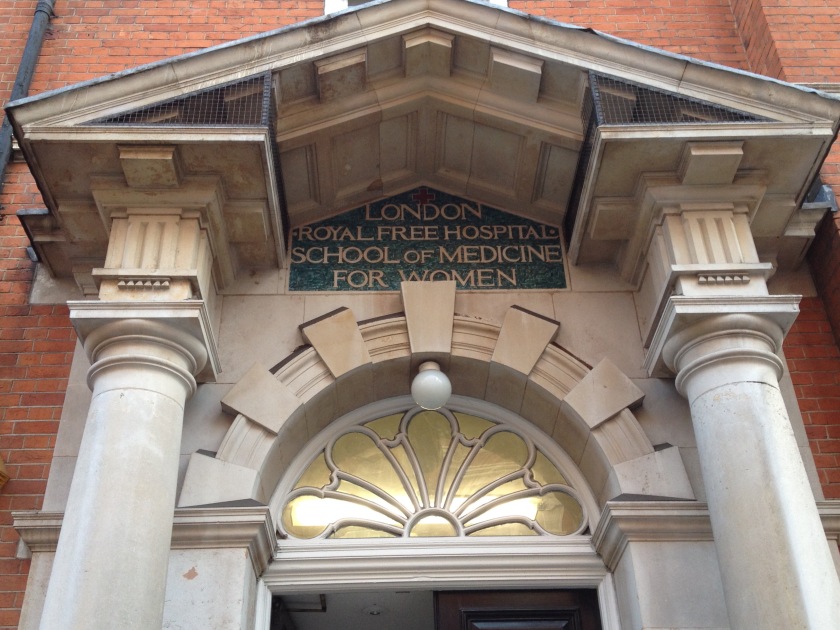
Just up from the Georgian charms of Bedford Square and around the corner from the swish new World Conservation & Exhibition Centre of the British Museum, the number 73 bus rumbles down Gower Street and on into Bloomsbury Street. As it stops at the lights, an observant passenger might spot the blue London County Council plaque to the left of the matching blue door of number 2 Gower Street.
Behind this door between the 1870s to the 1930s, four women of one remarkable family were making their mark upon the world though only one, Millicent Garrett Fawcett, is named on the plaque. So how did it begin?
Apparently, her mother Louisa told this story of how two of her daughters decided upon their careers. One evening at the family home in Aldeburgh, Suffolk, Elizabeth and Milly and Elizabeth’s friend Emily were brushing their hair by the fire, discussing the inequalities facing women and what they might do to advance women’s cause. Emily (aged 29) said women needed an education and she would open the universities to women, Elizabeth (aged 23) argued that women also needed an income so she would open up the professions, starting with medicine, and Milly (aged 13) was allocated the task of winning the Parliamentary vote. (Emily Davies co-founded Girton College Cambridge.)
Millicent Garrett Fawcett, who did indeed go on to lead the constitutional campaign for women’s suffrage, has long been one of my heroes. Her peaceful and persistent campaigning for women to get the vote began almost fifty years earlier than the direct violent action of the Women’s Political and Social Union (WSPU) so graphically depicted in last autumn’s film Suffragette. The National Union of Women’s Suffrage Societies (NUWSS), of which Millicent became President, continued to campaign for gender equality in different guises and, now as The Fawcett Society, celebrates its 150th anniversary this year.

Millicent’s older sister Elizabeth Garrett Anderson didn’t live in Gower Street but she did open up the medical profession. Elizabeth Garrett, became the first woman to qualify as a physician in Britain. She went on to found the New Hospital for Women (later the Elizabeth Garrett Anderson Hospital), was Dean of the London School of Medicine for Women and the first woman in Britain to be elected Mayor when she was elected Mayor of Aldeburgh, Suffolk in 1908.
Part of the Elizabeth Garrett Anderson hospital building is now incorporated into the offices of the trade union Unison and houses the Elizabeth Garrett Anderson Gallery

Elizabeth’s daughter, Louisa Garrett Anderson, trained as a doctor at the London School of Medicine for Women and in 1915 established the Endell Street Military Hospital with her companion Dr Flora Murray.
From the 1870s, long before Millicent moved in, No 2 Gower Street was the home and workplace of the firm of A&R Garrett House Decorators. A&R were the architectural decorators Agnes and Rhoda , (sister and cousin of Millicent and Elizabeth) and strictly speaking, the neat brass plate on the door that advertised their business contravened the terms of their Bedford Estate lease.
After a formal apprenticeship with the architect John McKean Brydon (who designed the Elizabeth Garrett Anderson Hospital and the London School of Medicine for Women) the two cousins became the first women professional house decorators, They designed carpets, textiles, furniture and wallpaper, exhibited in Paris and published a design book that ran to several editions. The composer Sir Hubert Parry employed them and they successfully tendered for interior design of the New Hospital for Women.


Millicent moved in with her sister Agnes in the 1880s after the death of her husband, the academic and Liberal MP Henry Fawcett and their cousin Rhoda. Millicent’s daughter Phillippa Fawcett lived here and from here set off for Newnham College (of which her mother had been one of the founders) where she made history and newspaper headlines with her success in the mathematics finals, when she was placed “above the senior wrangler”. In plain English, she was better than any of the men!
If you would like to find out more why not join my Garretts of Gower Street walk on Saturday afternoon 5th March.

Truly astonishing women! Imagine if that story about how they decided on their future careers was indeed true! And then contrast that with Henry Higgins’ (from the musical My Fair Lady) comment about women “straightening up their hair is all they ever do…” He’d bite his tongue next time! 🙂
While unfortunately I can’t make it to your walk, I’d be interested to learn more about the landscape gardener Fanny you mentioned in the invite to the walk. Any pointers? And thanks for this post!
LikeLiked by 1 person
Hi Stefanie, I’m glad you liked the post. I will run the walk again so hopefully you’ll be able to come. Fanny Wilkinson lived next door-but-one at no 6 Gower St. She was sister-in-law to Millicent & Agnes Garrett and one of the first women landscape gardeners, responsible for many public open spaces in London including Meath Gardens in Bethnal Green and the grounds around the Tower of London. I hope to write more about her here soon, so watch this space!
LikeLike
I will – and thank you!
LikeLike
Hi Sue, I’ve finally found some time to catch up on the GA group’s splendid work on their blogs. I really like your ‘Hidden’ series and am massively impressed with this one. What amazing women you’ve found in your travels, an ispiration to us all, not to mention would-be bloggers…
LikeLiked by 1 person
Love your ‘Hidden’ walks and most impressed by these ‘girls adventure stories’. Great stuff and all true ones too…
LikeLiked by 1 person